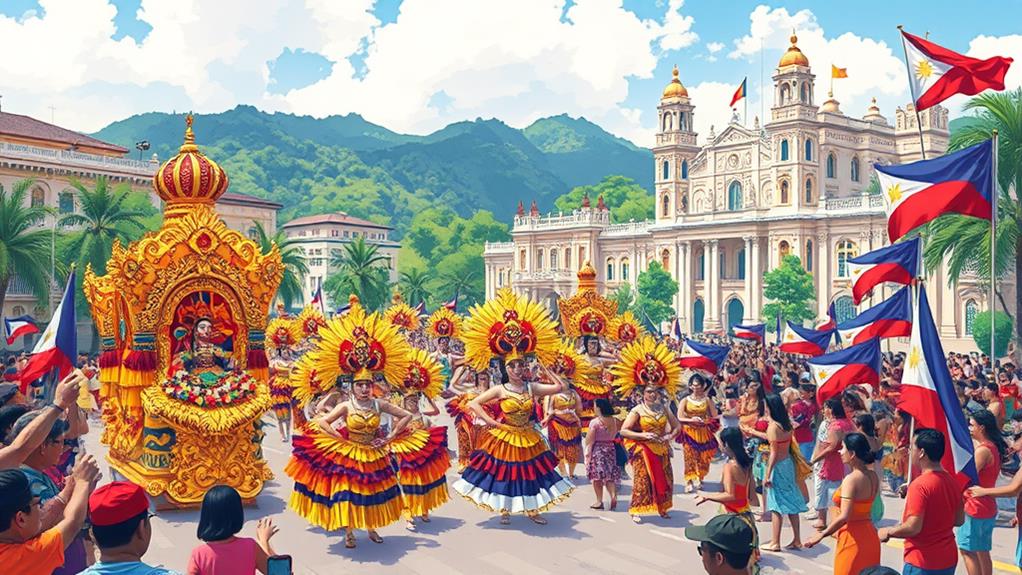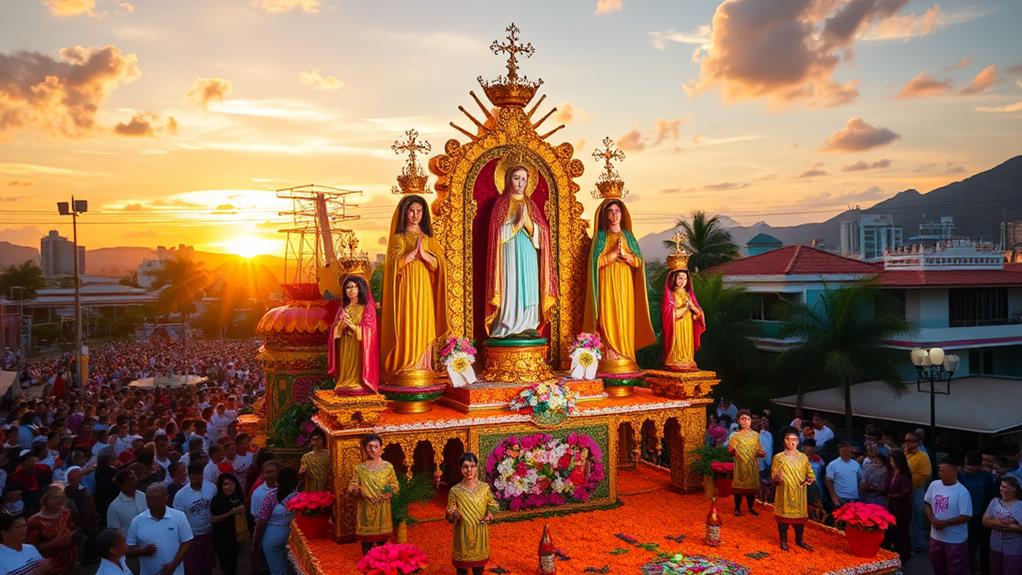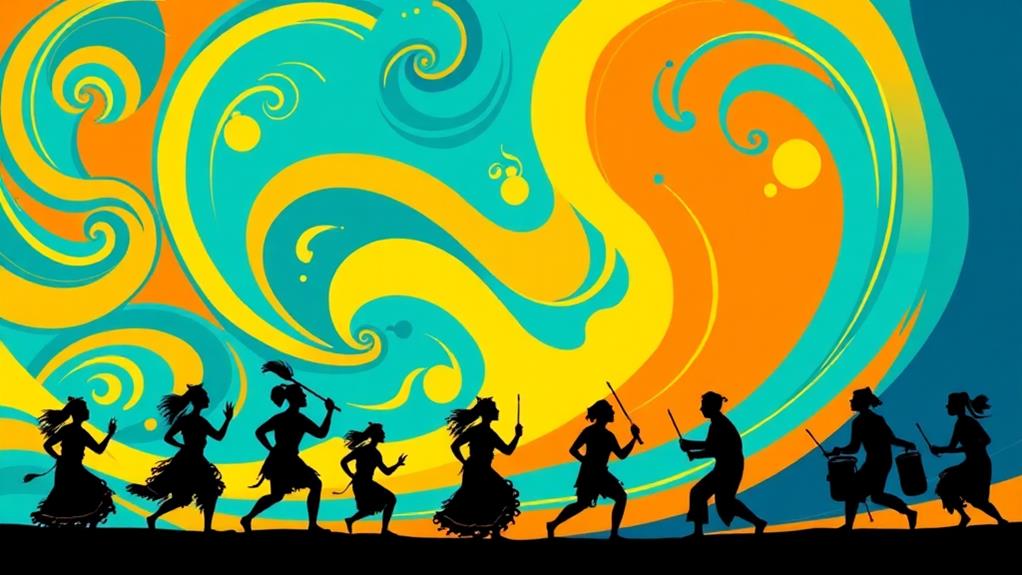Sinulog: A Grand Celebration of Filipino Culture
Sinulog, a vibrant and historic festival, attracts over a million visitors to Cebu each year. This grand festival honors Santo Niño de Cebu, the oldest Christian artifact in the Philippines, and symbolizes the acceptance of Roman Catholicism in the country.
A Rich History
Sinulog's roots date back to 1521, showcasing the rich Filipino culture and heritage. The festival features vibrant street dances, intricate choreography, and cultural events that highlight the country's artistic representations.
Cultural Significance
As you explore Sinulog, you'll discover its historical significance, cultural practices, and artistic representations that make it an unforgettable experience.
The festival is a testament to the country's rich cultural heritage, bringing people together to celebrate their history and traditions.
Historical Significance of Sinulog

Understanding the Historical Significance of Sinulog
The Sinulog Festival has its roots in 1521 when Ferdinand Magellan arrived in Cebu, introducing Christianity to the Philippines and venerating the Santo Niño. This event marked the beginning of the country's acceptance of Roman Catholicism.
The Baptism of Rajah Humabon and Queen Juana
The historical baptism of Rajah Humabon and his wife, Queen Juana, symbolized the acceptance of Christianity. This significant moment in Philippine history is commemorated through the Sinulog Festival.
Origin of the Name "Sinulog"
The name "Sinulog" comes from the Cebuano word "sulog," meaning current, which reflects the traditional dance's flowing movements.
The Evolution of the Sinulog Festival
Although the first organized Sinulog Festival didn't take place until 1980, it has grown to become one of the largest cultural celebrations in the Philippines.
It attracts over a million visitors annually.
Cultural Practices and Celebrations
The Sinulog Festival: A Celebration of Filipino Culture
The Sinulog Festival is a vibrant celebration of Filipino culture, showcasing the country's rich heritage and traditions.
The grand parade is a highlight of the festival, where street dancers wear colorful costumes and perform intricate choreography that mimics the movements of water currents, symbolizing the festival's origins.
The Traslacion Procession: A Display of Devotion
During the festival, thousands of devotees participate in the Traslacion procession, carrying the Santo Niño through the streets and demonstrating the Filipino people's deep devotion to their heritage.
This traditional procession is a testament to the significance of the Santo Niño in Filipino identity.
Cultural Events and Local Traditions
Throughout the festival, cultural events and activities highlight local traditions and artistry.
Modern representations of the Santo Niño are celebrated across the Philippines, reinforcing its importance in Filipino culture.
The festival culminates in the Hubo rite, a ceremonial stripping of the Santo Niño's vestments by priests, symbolizing reverence and marking the end of the festival.
A Glimpse into Filipino Devotion and Pride
Through these practices, the Sinulog Festival provides a glimpse into the Filipino people's strong sense of devotion and cultural pride.
The festival is a celebration of Filipino identity, showcasing the country's rich cultural heritage.
Religious Context and Significance

The Sinulog Festival: A Celebration of Faith and Tradition
The Sinulog Festival is a grand celebration that honors Santo Niño de Cebu, the oldest Christian artifact in the Philippines. This artifact symbolizes the introduction of Christianity by Ferdinand Magellan in 1521.
The festival features religious rituals, including novena masses and a solemn procession, which reflect the deep devotion of Filipino Catholics to the Santo Niño. The Santo Niño is believed to possess healing powers, which is a significant aspect of the festival.
The Sinulog Festival showcases the intersection of indigenous and colonial religious practices, highlighting the country's rich cultural heritage. The significance of the Santo Niño is further affirmed by its canonical coronation by Pope Paul VI in 1965, solidifying its role as a national cultural treasure.
Through the Sinulog Festival, you'll experience the vibrant cultural expressions of Cebu, where faith and tradition come alive in a celebration that's truly unique and unforgettable.
Patronage and Recognition of Santo Niño
The Santo Niño's patronage is deeply rooted in Cebu's history and culture. This significance extends beyond the Sinulog Festival, with its influence pervasive in the city's identity.
In 2002, Our Lady of Guadalupe was declared the principal patroness, but the Catholic Church clarified that intercession comes from God, not saints, ensuring the Santo Niño's continued importance.
The Santo Niño's image has been granted prestigious titles, including the military rank of Captain-General during the Spanish colonial era. Its current title is Celentísimo Capitán General de las Esfuerzas en Filipinas.
The Catholic Church has also recognized the Santo Niño's importance through papal decrees. Pope Innocent XIII officially moved the feast date to the third Sunday of January, and Pope Paul VI canonically crowned the image on April 28, 1965.
This devotion parallels the global veneration of the Infant Jesus of Prague, highlighting its significance in Catholicism beyond the Philippines.
Contemporary Developments and Artistic Representation

The Sinulog Festival's Evolution: A Blend of Tradition and Innovation
The Sinulog Festival has adapted to modern times by incorporating technology and innovative artistic representations of the Santo Niño. Live broadcasts and social media have increased global participation and reach. This fusion of old and new is also reflected in the artistic interpretations of the Santo Niño, which now showcase unique regional styles and cultural identities.
Visual Symbolism and Kinesthetic Movements
The festival's rituals now emphasize spiritual experience and cultural agency through visual symbolism and kinesthetic movements. These elements enhance the participants' spiritual connection and cultural expression.
Diverse Events and Cultural Significance
Art exhibitions and digital content are now integral parts of the Sinulog celebrations, highlighting the festival's cultural importance and attracting sponsorships and partnerships.
These events demonstrate the festival's significance and its ability to evolve while maintaining its cultural essence.
Contemporary Performances and Traditional Rituals
The integration of contemporary performances and traditional rituals has become a hallmark of the Sinulog Festival.
This blend showcases the ongoing evolution of practices surrounding the Santo Niño and Filipino spirituality, ensuring the festival remains vibrant and relevant.
Are There Similarities Between Sinulog and Ati-Atihan Festivals?
The Sinulog and Ati-Atihan festivals share several similarities in terms of their vibrant celebration of culture and tradition. Both festivals feature lively street parades, colorful costumes, and rhythmic music that showcase the rich heritage of the Philippines. The vibrant festival of kalibo and Sinulog are both significant cultural events that attract thousands of visitors each year.
Experiencing the Sinulog Festival
Immerse yourself in the vibrant Sinulog Festival, a nine-day celebration that showcases the rich culture of Cebu Island.
The festival's main attraction is the grand parade, which takes place on the third Sunday of January and draws over a million visitors.
Before the grand parade, catch the Fluvial Parade at 6 AM, followed by the Solemn Procession, which reenacts the historical baptism.
Throughout the festival, indulge in local delicacies like Lechon at food stalls and enjoy cultural performances, art exhibits, and concerts featuring local artists.
Discover the Sinulog sa Kabataan, a youth-focused celebration that adds to the festival's vibrancy.
As you take in the sights and sounds, you'll understand why the Sinulog Festival is a significant cultural event in the Philippines, boosting tourism and the local economy.
Frequently Asked Questions
What Is Sinulog Festival Celebrated For?
The Sinulog Festival celebrates the cultural significance of the Santo Niño, a symbol of the Philippines' historical origins in Christianity.
This celebration showcases religious devotion through vibrant parades and dance performances that highlight regional variations in artistic expressions.
The festival features community involvement, with participants showcasing their stunning festival attire.
Additionally, the festival boosts tourism, culminating in a joyous spiritual celebration.
What Food Is Served at Sinulog Festival?
Cebu Delicacies Abound at Sinulog Festival
Traditional Dishes Take Center Stage
At Sinulog Festival, you'll find a variety of traditional Cebu dishes, including Lechon, Puso, and Ngohiong.
These iconic dishes are a staple of the festival, showcasing the city's culinary heritage.
Festival Snacks and Street Food
Festival snacks and street food are plentiful, offering a taste of local cuisine.
You'll find food stalls and vendors serving up regional flavors, including sweet treats like Bibingka and Puto Maya.
Festive Beverages
To quench your thirst, try festive beverages that highlight the city's culinary traditions.
From refreshing drinks to sweet treats, there's something for everyone to enjoy.
Where Is Sinulog 2024 Held?
Sinulog 2024 is held in Cebu City, Philippines.
The festival takes place from January 11 to 26, 2024.
The grand parade will be held along Osmeña Boulevard and the Cebu City Sports Complex.
Key events are centered around the Basilica Minore del Santo Niño and Fuente Osmena Circle.
The main event is scheduled on the third Sunday of January.
How Is Sinulog Music Described?
Sinulog music is characterized by its unique rhythms, mimicking the traditional dance steps. These rhythms are a result of combining traditional instruments like gongs and drums with modern ones, creating an energetic sound.
The dance melodies are infused with cultural significance, making them festival anthems. For instance, the rhythmic beats of the drums and gongs are synchronized with the choreographed dance moves, evoking a sense of cultural pride.
You'll hear them during street performances, where the festive atmosphere is palpable. During these performances, the music is amplified, and the crowd's energy is electric.
Over time, the music has evolved, incorporating regional influences, while maintaining its core identity. For example, some Sinulog music incorporates guitar riffs or electronic elements, yet still retains its traditional roots.